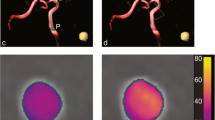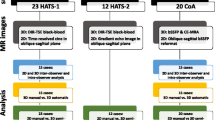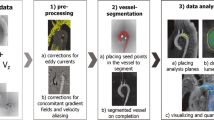Abstract
Purpose
4D PC-MRI enables the noninvasive measurement of time-resolved, three-dimensional blood flow data that allow quantification of the hemodynamics. Stroke volumes are essential to assess the cardiac function and evolution of different cardiovascular diseases. The calculation depends on the wall position and vessel orientation, which both change during the cardiac cycle due to the heart muscle contraction and the pumped blood. However, current systems for the quantitative 4D PC-MRI data analysis neglect the dynamic character and instead employ a static 3D vessel approximation. We quantify differences between stroke volumes in the aorta obtained with and without consideration of its dynamics.
Methods
We describe a method that uses the approximating 3D segmentation to automatically initialize segmentation algorithms that require regions inside and outside the vessel for each temporal position. This enables the use of graph cuts to obtain 4D segmentations, extract vessel surfaces including centerlines for each temporal position and derive motion information. The stroke volume quantification is compared using measuring planes in static (3D) vessels, planes with fixed angulation inside dynamic vessels (this corresponds to the common 2D PC-MRI) and moving planes inside dynamic vessels.
Results
Seven datasets with different pathologies such as aneurysms and coarctations were evaluated in close collaboration with radiologists. Compared to the experts’ manual stroke volume estimations, motion-aware quantification performs, on average, 1.57 % better than calculations without motion consideration. The mean difference between stroke volumes obtained with the different methods is 7.82 %. Automatically obtained 4D segmentations overlap by 85.75 % with manually generated ones.
Conclusion
Incorporating motion information in the stroke volume quantification yields slight but not statistically significant improvements. The presented method is feasible for the clinical routine, since computation times are low and essential parts run fully automatically. The 4D segmentations can be used for other algorithms as well. The simultaneous visualization and quantification may support the understanding and interpretation of cardiac blood flow.











Similar content being viewed by others
References
Abufadel A (2006) 4D segmentation of cardiac MRI data using active surfaces with spatiotemporal shape priors. Ph.D. thesis, Georgia Institute of Technology
Antiga L, Iordache EB, Remuzzi A (2003) Computational geometry for patient-specific reconstruction and meshing of blood vessels from MR and CT angiography. IEEE Trans Med Imag 22(5):674–684
Bade R, Haase J, Preim B (2006) Comparison of fundamental mesh smoothing algorithms for medical surface models. In: Simulation and Visualisierung, pp 289–304
Born S, Pfeifle M, Markl M, Gutberlet M, Scheuermann G (2013) Visual analysis of cardiac 4D MRI blood flow using line predicates. IEEE Trans Vis Comput Graph 19:900–912
Born S, Markl M, Gutberlet M, Scheuermann G (2013) Illustrative visualization of cardiac and aortic blood flow from 4D MRI Data. In: Proceedings of IEEE PacificVis, pp 129–36
Calkoen EE, Roest AA, van der Geest RJ, de Roos A, Westenberg JJ (2014) Cardiovascular function and flow by 4-dimensional magnetic resonance imaging techniques: new applications. J Thorac Imag 29(3):185–196
Carnecky R, Brunner T, Born S, Waser J, Heine C, Peikert, R (2014) Vortex detection in 4D MRI Data: using the proper orthogonal decomposition for improved noise-robustness. In: EuroVis short papers, pp 127–31
Cousty J, Najman L, Couprie M, Guinaudeau SC, Goissen T, Garot J (2010) Segmentation of 4D Cardiac MRI: automated method based on spatio-temporal watershed cuts. Image Vis Comput 28(8):1229–1243
Dìaz C, Robles LA (2004) Fast noncontinuous path phase-unwrapping algorithm based on gradients and mask. In: Proceeding of iberoameric congress on pattern of recognition (CIARP), pp 116–23
Dormand JR, Prince PJ (1980) A family of embedded Runge-Kutta formulae. J Comput Appl Math 6:19–26
Francois C, Srinivasan S, Schiebler M, Reeder S, Niespodzany E, Landgraf B, Wieben O, Frydrychowicz A (2012) 4D cardiovascular magnetic resonance velocity mapping of alterations of right heart flow patterns and main pulmonary artery hemodynamics in tetralogy of fallot. J Cardiovasc Magn Reson 14(1):16
Gasteiger R, Neugebauer M, Beuing O, Preim B (2011) The FLOWLENS: a focus-and-context visualization approach for exploration of blood flow in cerebral aneurysms. IEEE Trans Vis Comput Graph 17(12):2183–2192
Gasteiger R, Neugebauer M, Kubisch C, Preim B (2010) Adapted surface visualization of cerebral aneurysms with embedded blood flow information. In: Proceedings of eurographics visual computing in biology and medicine (VCBM), pp 25–32
Hennemuth A, Friman O, Schumann C, Bock J, Drexl J, Huellebrand M, Markl M, Peitgen HO (2011) Fast interactive exploration of 4D MRI flow data. In: Proceedings of international society of optics and photonics (SPIE) 7964
Hope MD, Wrenn J, Sigovan M, Foster E, Tseng EE, Saloner D (2012) Imaging biomarkers of aortic disease—increased growth rates with eccentric systolic flow. J Am Coll Cardiol 60(4):356–357
Hope MD, Sedlic T, Dyverfeldt P (2013) Cardiothoracic magnetic resonance flow imaging. J Thorac Imag 28(4):217–230
Hoppe H (1999) New quadric metric for simplifying meshes with appearance attributes. In: Proceedings of IEEE visualization, pp 59–66
Köhler B, Gasteiger R, Preim U, Theisel H, Gutberlet M, Preim B (2013) Semi-automatic vortex extraction in 4D PC-MRI cardiac blood flow data using line predicates. IEEE Trans Vis Comput Graph 19(12):2773–2782
Köhler B, Preim U, Grothoff M, Gutberlet M, Fischbach K, Preim B (2015) Robust cardiac function assessment in 4D PC-MRI data of the aorta and pulmonary artery. Comp Graph Forum (to appear)
Lombaert H, Sun Y, Cheriet F (2011) Fast 4D segmentation of large datasets using graph cuts. In: Proceedings of international society for optics and photonics (SPIE), p 79622H. http://proceedings.spiedigitallibrary.org/proceeding.aspx?articleid=724703
Mahapatra M, Buhmann JM (2013) Automatic cardiac RV segmentation using semantic information with graph cuts. In: Proceedings of international symposium on biomedical imaging (ISBI), pp 1106–1109
McLoughlin T, Laramee RS, Peikert R, Post FH, Chen M (2010) Over two decades of integration-based. Geometric Flow Comp Graph Forum 29(6):1807–1829
Ong F, Uecker M, Tariq U, Hsiao A, Alley MT, Vasanawala SS, Lustig M (2015) Robust 4D flow denoising using divergence-free wavelet transform. J Magn Reson Med 73(2):828–842
Piccinelli M, Veneziani A, Steinman DA, Remuzzi A, Antiga L (2009) A framework for geometric analysis of vascular structures: application to cerebral aneurysms. IEEE Trans Med Imag 28(8):1141–1155
Potters WV, Cibis M, Marquering HA, van Bavel E, Gijsen F, Wentzel JJ, Nederveen AJ (2014) 4D MRI-based wall shear stress quantification in the carotid bifurcation: a validation study in volunteers using computational fluid dynamics. J Cardiovasc Magn Reson 16(Suppl 1):P162
Preim B, Botha C (2013) Visual computing for medicine, 2nd edn. Morgan Kaufmann Publishers, Burlington
Roldán-Alzate A, Frydrychowicz A, Johnson KM, Kellihan H, Chesler NC, Wieben O, Francois CJ (2014) Non-invasive assessment of cardiac function and pulmonary vascular resistance in an canine model of acute thromboembolic pulmonary hypertension using 4D flow cardiovascular magnetic resonance. J Cardiovasc Magn Reson 16(1):23
Salvado O, Hillenbrand C, Zhang S, Wilson DL (2006) Method to correct intensity inhomogeneity in MR images for atherosclerosis characterization. IEEE Trans Med Imag 25(5):539–552
Stankovic Z, Allen BD, Garcia J, Jarvis KB, Markl M (2014) 4D flow imaging with MRI. Cardiovasc Diagn Ther 4(2):173–192
Taubin G, Zhang T, Golub G (1996) Optimal surface smoothing as filter design. In: Proceedings of European conference on computer vision, pp 283–92
van Ooij P, Potters WV, Guédon A, Schneiders JJ, Marquering HA, Majoie CB, Vanbavel E, Nederveen AJ (2013) Wall shear stress estimated with phase contrast MRI in an in vitro and in vivo intracranial aneurysm. J Magn Reson Imag 38(4):876–884
van Pelt R, Bescos JO, Breeuwer M, Rachel EC, Gröller ME, ter Haar Romenij B, Vilanova A (2010) Exploration of 4D MRI blood flow using stylistic visualization. IEEE Trans Vis Comput Graph 16(6):1339–1347
Venkataraman S (2010) 4D visualization of cardiac flow. NVIDIA GPU Tech Conf Talk
Walker PG, Cranney GB, Scheidegger MB, Waseleski G, Pohost GM, Yoganathan AP (1993) Semiautomated method for noise reduction and background phase error correction in MR phase velocity data. J Magn Reson Imag 3(3):521–530
Wolf RL, Ehman RL, Riederer SJ, Rossman PJ (1993) Analysis of systematic and random error in MR volumetric flow measurements. J Magn Reson Med 30(1):82–91
Zhang Q, Eagleson R, Peters TM (2009) Dynamic real-time 4D cardiac MDCT image display using GPU-accelerated volume rendering. Comp Med Imag Graph 33(6):461–476
Zhao F, Zhang H, Wahle A, Scholz TD, Sonka M (2006) Automated 4D segmentation of aortic magnetic resonance images. In: Proceedings of British machine vision conference (BMVC), pp 247–56
Conflict of interest
Benjamin Köhler, Uta Preim, Matthias Grothoff, Matthias Gutberlet, Katharina Fischbach and Bernhard Preim declare that they have no conflict of interest. Informed consent was obtained from all patients for being included in the study.
Author information
Authors and Affiliations
Corresponding author
Electronic supplementary material
Below is the link to the electronic supplementary material.
Supplementary material 1 (mp4 109124 KB)
Rights and permissions
About this article
Cite this article
Köhler, B., Preim, U., Grothoff, M. et al. Motion-aware stroke volume quantification in 4D PC-MRI data of the human aorta. Int J CARS 11, 169–179 (2016). https://doi.org/10.1007/s11548-015-1256-4
Received:
Accepted:
Published:
Issue Date:
DOI: https://doi.org/10.1007/s11548-015-1256-4




